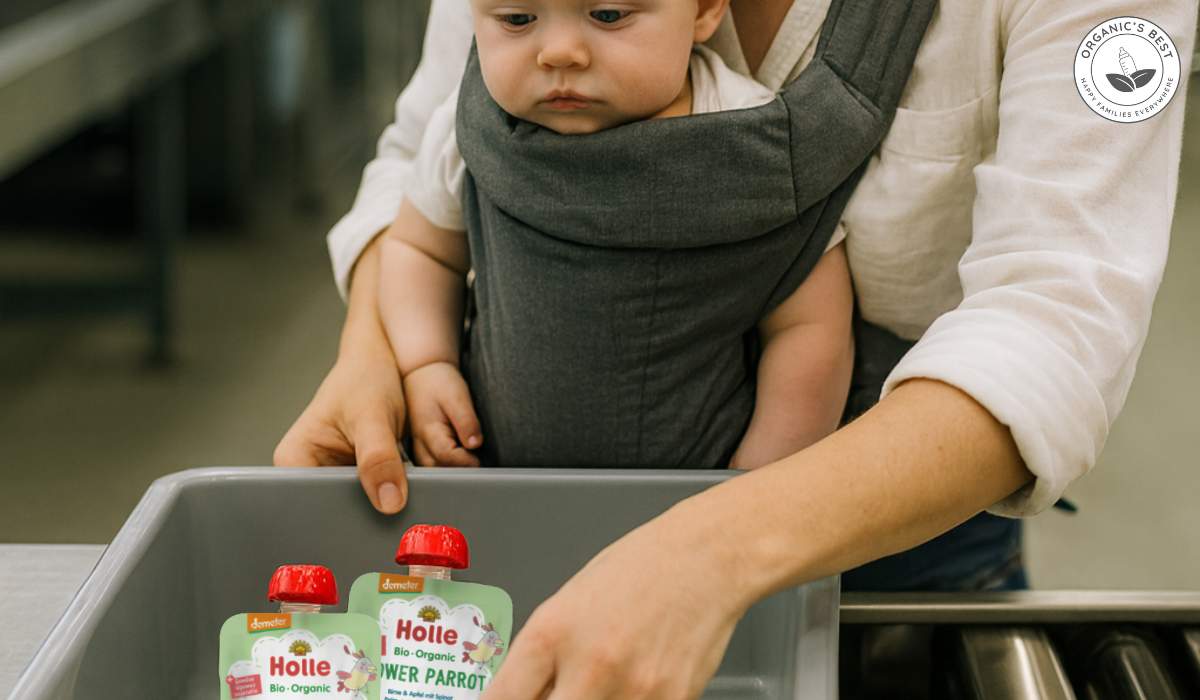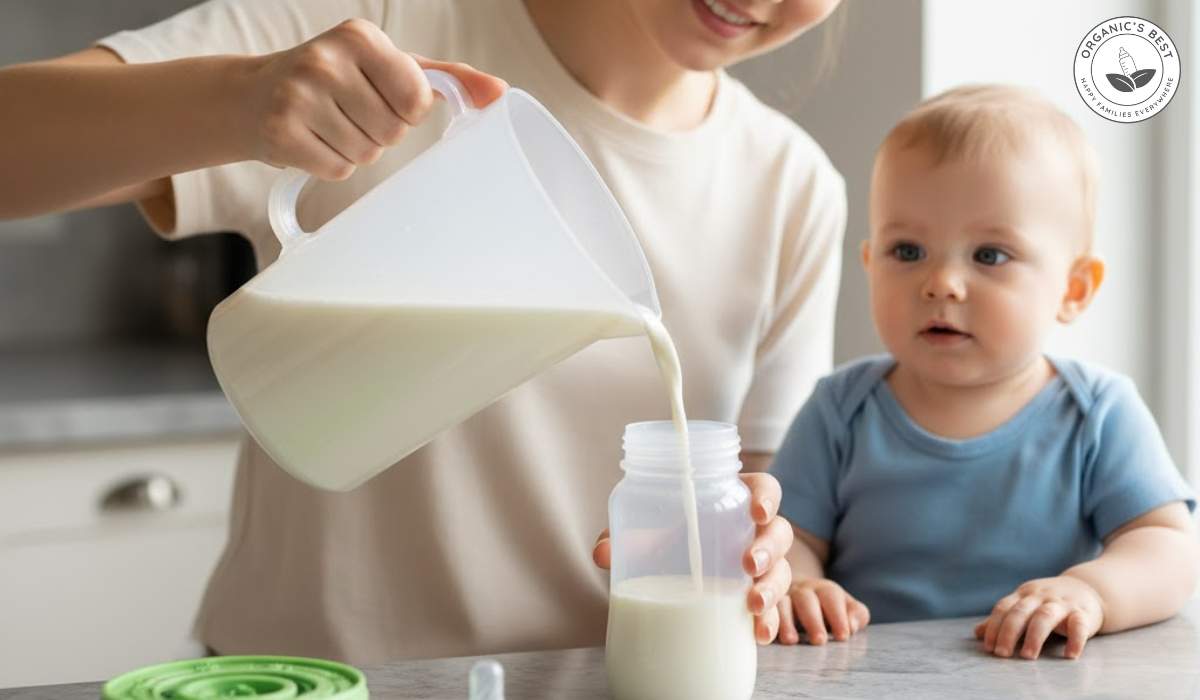Click to Get 2 FREE Boxes/Cans
Only New Customers! Click HERE to Get 2 Extra Boxes/Cans for Free With Your First Order.
BABY FORMULA
Offering new parents top-quality European infant formula from renowned brands like HiPP, Holle, Kendamil, and more. If you’re uncertain about which product to choose, our Formula Finder can help you make the best decision for your baby.
Baby Food
Offering new parents a premium selection of European baby foods, including jars, pouches, cereals, and snacks from esteemed brands like HiPP and Holle.
When to Begin Introducing Solids to Baby
by Agustina Fernandez September 26, 2023 10 min read

The journey from exclusively breastfeeding or formula feeding to introducing solids to baby is a remarkable stride that not only marks the expansion of your little one's palate but also plays a pivotal role in their overall development.
As babies embark on this culinary adventure, their expanding taste buds encounter new textures, flavors, and nutrients, fostering healthy eating habits from the outset. Beyond the nutritional aspect, introducing solids is also a sensory and social experience that lays the foundation for a lifetime of shared meals and the joy of discovering the world of food.
In this week's article, we will delve into how to select the first solid foods, when to introduce them, and how to overcome any challenges that may arise during this exciting time!
Table of contents
- Identifying the Right Time to Introduce Solid Foods
- Selecting Your Baby's First Solid Foods
- Step-by-step Approach to Introducing Solids
- Baby-led Weaning Vs. Spoon-feeding: Understanding the Difference
- Overcoming Challenges When Introducing Solids
- Frequently Asked Questions About Introducing Solids
Identifying the Right Time to Introduce Solid Foods
While every child's developmental timeline is unique, there are key indicators that collectively signal the arrival of the right moment for introducing solids. These signs offer glimpses into your baby's physical and cognitive progress, which can let you know that it is time to make the leap from just breast milk or baby formula to baby food!
Signs Your Baby is Ready for Solids
If you observe the following signs, then it might be time to consider starting this transition!

- Can sit upright independently
- Has neck and head control
- Opens mouth when presented with food
- Able to swallow instead of pushing objects out of their mouth
- Bring objects to their mouth and attempts to grasp small items
- Ability to transfer food from the front of the tongue to the back
Recommended Age Range to Introduce Solid Foods
So, now the question arises: when should your baby begin eating solid foods?
The European and North American Societies of Gastroenterology, Hepatology, and Pediatric Nutrition (ESPGHAN, NASPGHAN) recognize the importance of certain developmental milestones, particularly in the realms of renal, immunological, gastrointestinal, and neurological growth.
As a result, they suggest that most babies should be introduced to complementary foods not before 4 and not later than 6 months. However, the American Academy of Pediatrics (AAP) generally recommends starting solids closer to 6 months. Ultimately, it's important to assess your baby's individual readiness and consult your pediatrician for personalized advice.
Introducing baby foods before 4 months old is not recommended because it can cause necrotizing enterocolitis, a serious gastrointestinal problem (source). It is important to follow these recommendations because if your baby is introduced to solids too early or too late it can impact digestion, food allergy, and even long-term eating habits.
Selecting Your Baby's First Solid Foods
Now that you have determined that your baby is ready to make this transition, where do you start?
According to current guidance, oatmeal, such as Holle's Demeter quality baby porridge is a preferred choice for your baby's first food over traditional rice cereal. Regardless of the product that you choose, it is advisable to start with iron-fortified cereals and single-grain cereals, which can be mixed in a bowl with a little breast milk or formula according to the product instructions, to help adjust your little one to the new tastes and textures.
Once you are ready to expand past oatmeal, we also offer a diverse selection of baby food pouches and snacks sourced from leading organic European brands.
Understanding Your Baby's Nutritional Requirements
Babies experience remarkable growth and development during their first year, and their nutritional requirements evolve alongside these changes. As parents, it's essential to provide a well-rounded diet that caters to their changing needs.
Following advice from the Centers for Disease Control and Prevention, at around the age of 6 months, your child reaches a developmental stage where introducing solid foods becomes appropriate. As your child progresses to 7 or 8 months old, their palate and capabilities expand, allowing them to explore a diverse range of foods from various food groups.
Some great first foods to introduce during this time are infant cereals, protein sources like meat, fruits, vegetables, and grains, as well as dairy products like yogurts and cheeses.
Unpacking Potential Food Allergies and Risks
We get it—when it comes to your baby's food, you want to be super cautious. And yes, a food allergy is a big concern. But guess what? The old-school advice of holding off on allergenic foods to prevent food allergies might not be the way to go.
Let's break it down and take a more relaxed approach to those potential allergens!
Old Food Allergy Advice
Traditionally, the advice was to wait it out before introducing potentially allergenic foods like peanuts and eggs. The thought was younger babies' immune systems needed time to build up their defense's against potential allergies.
Although, recent studies have revealed that introducing potentially allergenic foods when your baby begins complementary feeding might not increase the risk of sensitization or allergic reaction, instead, it could actually foster immunological tolerance! Despite this change, it's important to exercise caution, especially if close relatives have a history of food allergies.
Current recommendations suggest that common allergens should be introduced in small amounts around 6 months of age, one at a time, while allowing at least 3-5 days to pass before introducing another, in order to assess your baby's reaction to that food. Additionally, the first taste of a highly allergenic food is best given at home, so that you can be quick to act if your baby does have a reaction.
Here are some of the most common allergens to implement this practice with:

- Peanuts and tree nuts 🥜
- Eggs 🥚
- Cow's milk products 🐄
- Wheat 🌾
- Crustacean shellfish 🦞
- Fish 🐟
- Soy 🌱
Step-by-step Approach to Introducing Solids
Alright, parents, let's break down the solid food journey into bite-sized steps.
Starting With Purees and Soft Foods
We're kicking things off with purees and soft foods. This is where baby food pouches come in handy. Pouches are a versatile solution offering convenience and a variety of healthy options.
Holle's organic pouches, which are EU organic and often also Demeter quality, are made from 100% fruits, veggies, cereal, and yogurt, making them ideal snacks on the go. Free from unwanted additives, they're a superior choice for quality and taste, so take a look at the options that are suitable from 6 months onwards for weaning.
If you are hoping to start the introduction a little earlier, HiPP pouches that are suitable for babies as early as 4 months. They are a fantastic choice, made from 100% organic fruits, grains and veggies.
Gradually Introducing a Variety of Foods and Textures
As your little one gets the hang of those purees, it's time to level up. Think of this phase as culinary exploration for tiny taste buds. It's all about introducing a variety of foods and textures. From mashed veggies to soft fruits, each taste experience is a step towards expanding your baby's palate.
The Balance Between Solid Food Intake and Milk Feeds
Now, let's chat about balance. While starting solid foods steals the spotlight, remember that breast milk or formula feeds still play a crucial role even after your baby reaches 6 months of age all the way up until they reach their first birthday. They're a steady source of essential nutrients that your baby needs for growth and development. So, as you're introducing solids, keep the milk feeds flowing!
While introducing complementary foods, you can continue with milk feeds for up to two years or even longer.
Essential Safety Guidelines: How to Prevent Choking
We already touched on choking hazards above, but why is this so important?
Well, young children under the age of 4 face an increased risk of choking due to several factors. The first being that they may lack the molars needed to effectively grind hard or chewy foods into smaller pieces. They also are easily distracted during meals, which can divert their attention from eating safely. On top of that, their smaller airways make them more susceptible to blockages.
Although choking hazards can arise from any food, certain foods pose a higher risk. To safeguard children under four it is recommended that you:

- Avoid offering hard foods (like raw carrots).
- Steer clear of small, round foods (such as whole cherry tomatoes).
- Be cautious with smooth, sticky items (like thickly spread peanut/nut butter).
- Minimize foods that are tough to chew (like dried fruit).
Make sure that your food is prepared safely by following these tips:
-
Mix cereals and cooked grains with liquid (breast milk, formula, or water) to ensure a smooth consistency for easy swallowing.
-
Transform vegetables, fruits, and other foods into smooth textures through mashing or pureeing.
-
Cook firm fruits and vegetables like apples and carrots to make them suitable for mashing or pureeing.
-
Before cooking, remove fat, skin, and bones from poultry, meat, and fish.
-
Once you progress from simply feeding them mashed or pureed food, make sure to cut soft items into pieces that are half to one centimetre in size.
-
Cut cylindrical foods like hot dogs into thin strips.
-
Create a calm and distraction-free mealtime environment.
-
Discourage eating while walking, running, lying down, or when in a moving vehicle.
-
Always supervise your young child or baby during meals and when they're drinking.
Baby-led Weaning vs Spoon-feeding: Understanding the Difference
Depending on what your goals are during this journey, there are different approaches you can take while introducing food to your baby. Let's look at the options.
Overview and Advantages of Baby-led Weaning
Baby-led weaning empowers your baby to take the lead, allowing them to explore foods at their own pace and develop self-feeding skills. This method involves offering appropriately sized and textured finger foods that your baby can grasp and bring to their mouth independently.
Overview and Advantages of Spoon-feeding or Traditional Weaning
Spoon-feeding, or traditional weaning, involves you, the parent, introducing foods to your baby with a spoon. You have control over the feeding process, offering purees or mashed foods that your baby may not yet be able to handle themselves.
How to Determine the Best Weaning Method for Your Baby
Selecting a weaning method depends on your baby's individual needs, preferences, and developmental stage. Baby-led weaning suits those who enjoy exploring textures and are eager to develop self-feeding skills. It promotes independence and can enhance the joy of mealtimes. On the other hand, spoon-feeding might be preferred if you want more control over what your baby consumes and if they need a more gradual transition to eating solid foods.
Ultimately, the choice between baby-led weaning and spoon-feeding is a personal one. You might even choose to incorporate elements of both methods, tailoring your approach to what works best for your baby and your family.
Overcoming Challenges When Introducing Solids
Introducing solids can sometimes lead to surprising twists.
If your baby isn't exactly jumping for joy at the sight of new foods, don't fret. It's a common challenge that many parents face. We'll delve into effective strategies to handle this situation, ensuring that mealtime remains a positive experience for both you and your little one.
Let's look at some possible solutions:

Start Gradually: If your baby is hesitant, start by offering small tastes of new foods without any pressure. Give them time to explore textures, smells, and tastes at their own pace.
Timing Matters: Offer solids when your baby is calm and not overly hungry or tired. A content baby is more likely to be curious about new foods.
Variety and Texture: Experiment with different textures and flavors. Some babies prefer purees, while others might enjoy mashed or finger foods. Gradually introducing variety can pique their interest.
Follow Their Cues: Pay attention to your baby's signals. If they're turning away or spitting out food, it might be a sign they need more time. On the other hand, if they show interest, keep offering a mix of foods.
Model Eating: Babies often learn by watching. Sit down to eat food with them and show how enjoyable mealtime can be. They might be more inclined to try a new food if they see you enjoying it.
FAQs About Introducing Solids
Finally, as you embark on your baby's solid food journey, it's natural to have questions. Let's tackle some common queries to help you navigate this exciting phase:
What Baby Food Should I Introduce First?
The initial foods you introduce can set the tone for your baby's culinary adventure. Opt for single-ingredient foods like iron-fortified baby cereals or pureed fruits and vegetables. Start with options that are easy to digest and less likely to trigger allergies.
Is It OK to Give My Baby Solids at 4 Months?
Introducing solids at 4 months is possible, but it's crucial to watch for signs of readiness. Babies are generally ready when they can sit up with support, show interest in food, and have good head control. Consult your pediatrician to ensure your baby is developmentally prepared.
Is It Better to Start Solids at 4 Months or 6 Months?
The ideal timing for starting solids varies for each baby. The American Academy of Pediatrics recommends around 6 months as babies are typically better equipped to handle solids at this age.
What Is the 3-Day Rule for Introducing Solids?
The 3-day rule involves introducing new foods one at a time and waiting for three days before introducing another new food. This approach helps you identify any potential allergies or sensitivities, allowing you to pinpoint the cause if any reactions occur.
How Would You Introduce Solids to a Baby for the First Time?
Start with a relaxed environment and a time when your baby is curious and not overly hungry. Offer a small amount of single-ingredient pureed food on a spoon. Watch for your baby's reactions and cues. It's about exploration and learning, so take it step by step.
Conclusion
Remember, every baby's diet is unique, and their transition to solids will unfold in its own way. Flexibility, patience, and a supportive atmosphere are essential ingredients for a successful journey. So, embrace the mess, celebrate the milestones, and savour these precious moments of exploration and discovery!
|
Disclaimer: Please be aware that this information is based on general trends in babies, and it is not medical advice. Your doctor should be your first source of information and advice when considering any changes to your child’s formula and when choosing your child’s formula. Always consult your pediatrician before making any decisions about your child’s diet or if you notice any changes in your child. Breastfeeding is the best nutrition for your baby because breast milk provides your child with all the essential nutrients they need for growth and development. Please consult your pediatrician if your child requires supplemental feeding. |
Agustina Fernandez
Dr. Agustina Fernandez earned her medical degree from the prestigious Universidad Nacional de Córdoba, Argentina. With a deep-rooted passion for pediatrics, Dr. Fernandez is currently on the path to specializing in children's healthcare. Recently, she has delved into the vital field of infant nutrition. Her research interests include breastfeeding, infant formula, and baby food in little ones’ formative years. Dr. Fernandez's commitment to this area of study underscores her dedication to ensuring the health and well-being of children from their earliest days.
Leave a comment
Comments will be approved before showing up.
Also in Organic Infant Nutrition and Health Blog

Everything You Need To Know About Winter Pregnancy: Essential Tips for Moms-to-be
by Agustina Fernandez December 16, 2025 8 min read
Read More
Can You Bring Baby Food Pouches on a Plane? Essential Tips for Parents
by Agustina Fernandez December 09, 2025 7 min read
Read More
The Formula Pitcher: Is It Safe To Make A Whole Pitcher Of Baby Formula?
by Agustina Fernandez December 02, 2025 8 min read
Read More
Reviewed by Dr. Bardha Citaku, MD
-

Dr. Bardha Citaku: Medical Reviewer of Organic's Best Blog
Dr. Bardha Citaku completed her medical studies at the University of Prishtina in Kosovo, where she began her journey into the field of medicine. She has since developed a career in medical research, contributing to projects with notable organizations, including the World Health Organization (WHO).
